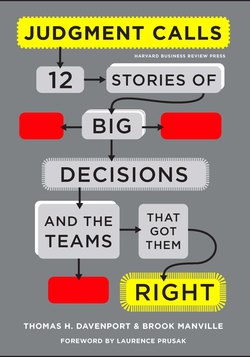Читать книгу Judgment Calls - Thomas H. Davenport - Страница 23
На сайте Литреса книга снята с продажи.
Оглавление2
WGB Homes
How Can We Sell This House?
GREG BURRILL IS the owner and founder of WGB Homes. WGB has built over 1,800 homes in the western and southern suburbs of Boston. Boston is known for its “Route 128” technology corridor, but in fact most of the technology activity in recent years has taken place near Interstate 495, the “outer loop” that when originally built, ran through farms, fields, and small towns. Now it's the home of EMC, Hewlett-Packard, Staples, and other large employers, and Greg Burrill has built a lot of homes for their executives and employees. The area—alternatively known as MetroWest or the Blackstone Valley—also has good access to downtown Boston via the Massachusetts Turnpike and commuter rail service. It's been the primary growth area for residential real estate in Boston over the last twenty or thirty years, since there was plenty of both open space and jobs in the area.1
Burrill's been in business for thirty-nine years—through good times and bad for home builders—so he must be doing something right. He's conservative in his approach to his business, never going into deep debt like many home builders. “You have to have low loan-to-value ratios, and you have to have cash,” he notes. He also simply slows the pace of development and construction down when times are tough. They've certainly been tough over the last several years; Burrill doesn't remember a period of decline in residential real estate that lasted this long.
WGB Homes is primarily a family business. Greg Burrill's brother Steve is its vice president. His two daughters, Erica and Vanessa, both work for the company, as does one son-in-law. In a newspaper article about the company, a buyer of one of their homes described them as “nice, honest, fair people.”2 The company's pattern is to build one development project at a time—enough to keep all members of the family and company busy, but not anything that will bankrupt the company in a residential construction turndown. They do it all—buy the raw land, develop the land, build houses, and market them. They will occasionally even resell a house in one of their neighborhoods if approached by the owner.
WGB's current development project is called Brookmeadow Village. It's in the semirural town of South Grafton. Grafton was one of the Massachusetts towns known for “praying Indians”; the Pilgrim missionary John Eliot established a church and school for the Nipmuck tribe there in 1671. It was later known briefly for woolen manufacturing. Today it's mostly an exurb for young families who can't afford the high housing prices nearer Boston. It's still not cheap, however; new houses in Brookmeadow Village average just over half a million dollars.
Brookmeadow Village is a ninety-one-lot neighborhood. Burrill prides himself on building neighborhoods, not subdivisions, and the company sponsors parties and picnics throughout the year for the neighborhoods it has built. Brookmeadow Village is located on one hundred thirty acres and includes a small retail complex, seventy-five acres of open space, and over two miles of walking trails leading down to baseball and soccer fields. All houses are Energy Star certified—Burrill's first development with that qualification. Overall, the selling of the project has gone well given the difficult economy; over twenty homes have been built and sold—including one to Erica Burrill and her husband.
